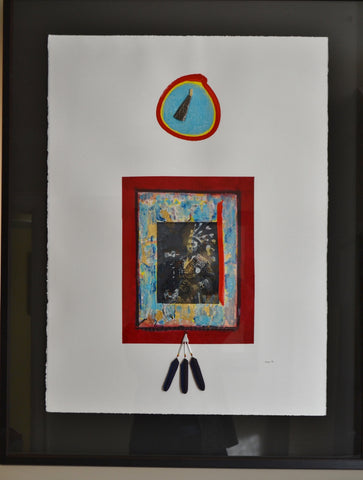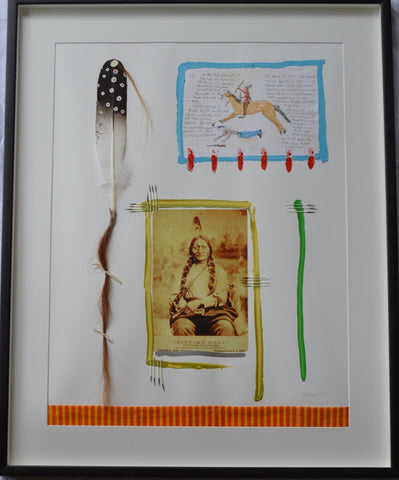
Colonization by Barry Ace, 2012
Some art experts classify all post 1945 indigenous works as contemporary indigenous art in Canada, regardless of the actual period in which it was created. Since 1945, most West Coast, Inuit and Eastern Woodlands art is still based upon traditional themes and subjects. However, we feel that there are contemporary indigenous artists in Canada who have been creating some of the most exciting and important works of art to come out of Canada since the year 2000. Many of this new cache of leading artists have appropriated Western art theory, concepts and techniques while incorporating their traditional spiritual and cultural values. Their art makes statements on a vast array of political, historical and social issues.
Twenty-first Century contemporary indigenous art from Canada has evolved from the works of the painter Norval Morrisseau and other well-known artists such as Carl Beam, Bob Boyer, Robert Houle, Gerald McMaster and Pierre Sioui.
Amongst these artists Carl Beam (Ojibwe) illustrated this evolution of contemporary and post-modern indigenous art. Beam is known for his multimedia works. In one work of art (Semiotica I) Beam combines images of a soaring eagle, a spacecraft ready to be launched, a traffic light and parking meter. Carl Beam spoke to a Canadian and international audience on social and global issues facing humanity.
Contemporary work by Aboriginal artists has expanded into performance art, new media, audio-visual and installation projects. One successful Ojibway artist who uses multiple media for expression is Rebecca Belmore, who in 2005 represented Canada at the Venice Biennale.
Another acclaimed contemporary artist Brian Jungen, uses the ordinary objects of popular culture and everyday life to make statements about consumer culture. Perhaps Jungen’s most famous work is the Nike Air Jordans sewn into Northwest Coast style masks.
The Langford Gallery is pleased to present some of the works of one of our favourite contemporary indigenous artists in Canada; Barry Ace (b.1958). Barry is an internationally recognised and highly successful Anishinaabe (Odawa) artist. He is an intellectual, multi-talented artist with one foot in tradition and one foot in the 21st Century. He recently retired after a long career as a senior advisor (responsibilities included curating) in the federal government and now is devoting all of his energies to his creative endeavours. This includes writing, dancing, fashion design and artistic works. In his own words Ace uses “mixed media paintings and assemblage textile works to explore various aspects of cultural continuity and the confluence of the historical and contemporary.”
Barry Ace has exhibited extensively in Canada, the United States and Europe (mostly Zurich, Switzerland). His work can be found in numerous public and private collections in Canada and abroad, including the Regional Municipality of Ottawa-Carleton (Ottawa); Royal Ontario Museum (Toronto); Ottawa Art Gallery (Ottawa); The Canada Council Art Bank, (Ottawa); and the Nordamerika Native Museum (Zurich, Switzerland).
Barry Ace’s popularity has been rising rapidly. Between 2014 and 2016 the prices for his works have risen roughly 5 times. Barry Ace's new works are now exclusively represented by Kinsman Robinson one of Toronto's most respected galleries of contemporary Indigenous art (e.g Robert Houle, Robert Davidson) and Canadian art. For information on Barry Ace’s work and exhibitions please visit his website at http://www.barryacearts.com/
In his artist statement, Ace explains that his mixed media and textile works “explore various aspects of my Anishinaabe (Odawa) culture, drawing its primary inspiration from sourced historical images, personal photographs, found objects and material culture research” including for example a graphite narrative; a porcupine quill, a bird feather; a beadwork motif; or electronic components designed to create a deliberate tension. His “work is often multi-layered with meaning and references couched in a subtle and ethereal visual landscape for personal reflection and contemplation".
Notable amongst his creations is the historical mixed media series from 2007 to 2012. The Langford Gallery has 4 acrylic and mixed media on paper works from this series:
Little Shell by Barry Ace (2011). Thomas Little Shell (c.1830-1901) was a chief of a band of the Ojibwe in the second half of the nineteenth century. This work features an image of Little Shell with a circle overlain to highlight the image. A reverse image profile in brown sits beside the image. Little Shell is dressed in traditional clothes and tomahawk and the images are floating in a blue background which looks like blue sky and clouds.

Colonization by Barry Ace (2012). This work has an geometric abstract feel with 2 vertical blocks in red and green. Featured in this work are 5 distressed images partially covered with black marks of the Lipe couple (3 female, 2 male) dressed in late 1800s Western dress. The orange circle is used to highlight the image of the westernized couple.

Maungwudaus by Barry Ace (2012). The original photo, reproduced in this piece, is actually an 1840's daguerreotype, which currently hangs in the National Gallery of Canada and is one of the earliest photographic portraits of an indigenous person in Canada. The subject is Maungwudaus who was a member of the Anishnaabe Nation of the New Credit Mississauga territory (Upper Canada). He found acclaim as a performer in a Wild West show. The image of Maungwudaus is highlighted using frames of red blue/orange. The work also includes a bell from a dancing skirt and 3 small feathers.

Ta Tonka Iyotonka (Sitting Bull) by Barry Ace (2007). The large photo of Sitting Bull (the Sioux Chief who fought at Little Bighorn) which Ace uses in this piece was originally taken by O.S. Goff in 1881.
The text in this piece (accompanied by a pencil crayon of Joseph White Bull on horseback with the fallen Custer) uniquely tells of an unconfirmed story of Custer's death at the hands of Sitting Bull's nephew, Joseph White Bull, at Little Bighorn.
The yellow image of Sitting Bull is highlighted with a yellowish border and quills. The work consists of the primary colours – red, blue and yellow - with some green.
This mixed media work includes quills, feather, hair, acrylic, paper, pencil, photography and cloth.

Please visit our Paintings and Prints Collection for more on this series.

Comments on post (0)
Leave a comment